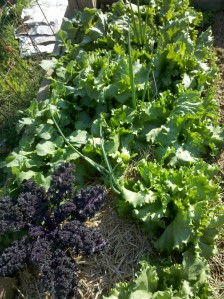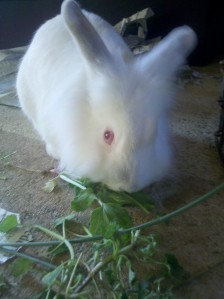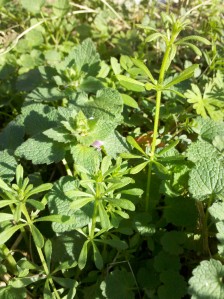Hello to all! I would like to indtroduce you to the newest member of our Farmin’ Family, his name is…Beckham-Bo Bunny! Dont look at me like that! I didnt name him!

He's still camera shy, but we'll work on that! 🙂
Mr.Beckham-Bo Bunny is one year old and looks as though he could be Wolverine’s Pet Rabbit (notice the mutton chops ), we got him for free from a family who could no longer care for him, as it turns out the wife was painfully allergic to rabbits. Needless to say, he is very skiddish and has never truly been held for long because of the allergy issue so were going to really have to work with him! He seemed fairly healthy aside from his enormously overgrown claws, which seemed to be tender to the touch, so instead of trying to clip his nails ourselves, we decided to take him to the vet’s office. Though I probably could have attempted the job myself ( its really not that difficult), I feared the quick had grown ( the quick is the small vein located in an animals claws that, if clipped, will bleed profusely) as well as his nails, and I really didn’t want to deal with a bleeding bunny foot! So off we go to the Friendly local Veterinarian’s office for a quick check up and grooming session…..$92 later, as Bear and I limped away as if we’d been shot in the butt, I began to think of a carreer in the Vet’s bussiness! O.K., so Im kidding about that part, but $92? It turned out that our cute little rescue bunny came with a case of ear-mites in one ear and the only possible cure was to charge us; $38 for the office visit, $23.50 for a swab of the ear and a glance in a microscope, $22.50 for an injection of Ivermectin (which turns out to be a de-wormer) and $8 for a nail trim….WoW! Now I have never come across a case of ear mites in all of my bunny raising experience,(which is odd, because all of my bunnies come from the auction-house) and in my ignorance, I didnt think to take matters into my own hands with my knowledge of herbs and home remedies. I know, Bad Gwenevere! Always thouroughly research an animal your going to raise! But in my reading on rabbits, I only vauguely remembered something about ear mites, and vaguely remembering doesnt constitute full knowledge. Well I learned my lesson, and immediatly after the Vet’s Wallet lashing, I began my research and after hours of my nose stuck in books, my eyes stuck to the computer, and my ears stuck to the wisdom of my fiance’s Grandmother, here are my findings….I spent Waaayyy to much money!
Now onto the Home Remedies for Ear mites:
*Apparently, any type of oil, rubbed into the affected ear will smother the ear mites, however, the type of oil is widely debated. Some imply that mineral oil is the only way to go, while others swear on olive oil or canola. I personally would rather use a naturally based oil since any type of oil will seep through into the animal’s system. Something to think about also, is adding essential oils to further heal the ear. Eucalyptus or Grapefruit seed extract would be my choice for their antiseptic, healing and particularly their anti-fungal properties, because in some cases a fungus will appear after the death of the ear mites. This is rare, but worth a pre-defense.
Apply the oil/oil mixture to the inside of the ear with either a clean cotton cloth, cotton ball, or your fingers. Repeat about three times per day for a couple of weeks to make sure you smother not only the ear mites, but the succesivly hatching eggs as well.
*Apply a one part vinegar/two parts water mixture to the inside of the affected ear every day, about three times a day for a week. This is the recomended time, but I assume it would’nt get rid of the hatching eggs as well and you may have to repeat until all signs of infection are gone. This tends to dry the ear out more than the oil mixture, and should not be used on animals with sores from scratching too much, as it will sting. Vinegar is also said to clean out the debris and detritus from an affected ear. Similarly acidic in nature, lemon juice will also do the trick, while also making your bunny smell lemony fresh!
*Yellow Dock Root Extract: nine drops of the extract are diluted with one tablespoon of water. Fill half of a dropper with the mixture and place in the ears. Continue this treatment for many weeks (every other day), to prevent any new infections from eggs hatching. You can make this extract at home by adding as much chopped yellow dock root as will fit in a mason jar of your choosing, then cover completely with 80 proof vodka, cover and place in a dark, cool place for about six weeks, shaking to mix ever day. Strain the mixture and store in a dark colored, sealed jar. This is the simplest way to make a tincture and can be used for just about any herb. Im really not sure at all how this remedy is supposed to work. It may only be that the alchohol in the mixture succesfully dries out the mites, but many people have recomended it, so the herb may act in some way.
*As an after treatment, My fiance’s Grandmother, Eve, gave me a little of her Goldenrod ointment. Not only will this help to heal the damage caused by the ear mites, it will also re-moisturize the ear and prevent infection from occuring. Perhaps I’ll do a post on how to make the Goldenrod ointment at a later date.

His ears seems to be doing better, but notice how the far one droops? This is one sign of ear mites. Sadly, He is in quarentine inside the house until we get rid of them.
Though I am now armored with this alternative knowlege, I will continue with the last two shots of Ivermectin the Vet recomended, I would not want any ill-effects caused because I chose to discontinue a treatment early.And Though Ivermectin is a De-Wormer, Eve also says that yes, it will get rid of the ear mites, along with any other bug-type creature that would possibly infect poor Mr Bo-Bunny. I will, however, be using these home remedies if ever I come across Ear Mites again, first of all, I don’t enjoy wallet- crushing vet bills, secondly, there are rumors that Ivermectin has been known to cause brain damage.
Either way, We now own one very expensive bunny! Do you know what his punishment will be for costing us so much? A life of eating crunchy, fresh wild greens, Playing in the sunlit grass, and Mating with Beautiful Does! Not too bad a punishment if I do say so myself!
-Gwenevere

You can really see the Wolverine-like Mutton Chops in this pic, Apparently that colorful object next to him is his favorite toy, and yes, he does carry it around when he's playing! 🙂





































